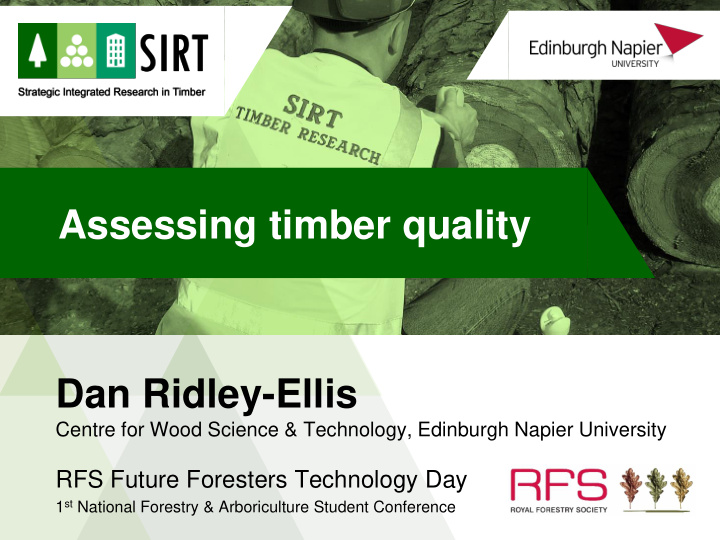



Assessing timber quality Dan Ridley-Ellis Centre for Wood Science & Technology, Edinburgh Napier University RFS Future Foresters Technology Day 1 st National Forestry & Arboriculture Student Conference
blogs.napier.ac.uk/cwst 20/10/2017 2 Image : wood for good
What is wood quality? • Wood quality depends on the application • For construction Appearance and knots Distortion – Strength (aka MOR) Durability – Stiffness (aka MOE) Sizes – Density Ease of processing – Variation in the above Etc… • But be aware: It is not all about density! blogs.napier.ac.uk/cwst 20/10/2017 3
Density – not always a good thing If only we were a bit heavier! blogs.napier.ac.uk/cwst 20/10/2017 4
blogs.napier.ac.uk/cwst 20/10/2017 5
Reducing wastage Species choice Effects of tree breeding Higher penalty for incorrect decision Young trees Cost More cost incurred in processing Harvest age trees Segregation to other markets Log / stem data Logs at the forest (forest data) Cost Logs at the sawmill Green cants Fail pre-grading Timber data predictive of dry Green sawn timber (log / stem data, forest data) Cost Dry sawn timber Fail grading Co-products Timber data Pass grading (log / stem data, forest data) Secondary Fail quality control Cost Waste processor/end user Visual assessment? blogs.napier.ac.uk/cwst 20/10/2017 6
Simple Models for forest growth (yield) • Site can estimate timber quality (so long as we have the • Spacing underpinning research) • Thinning • Age • DBH • Crown ratio • Slenderness • Branches blogs.napier.ac.uk/cwst 20/10/2017 7
• Increment coring • Pin penetration • Resistance drilling • Acoustics blogs.napier.ac.uk/cwst 20/10/2017 8
blogs.napier.ac.uk/cwst 20/10/2017 9
Standing tree acoustics SIRT benchmarking data With a perfect grading machine Moore, J. R., Lyon, A. J., Searles, G. J., Lehneke, S. A., Ridley-Ellis, D. J. Within- and between-stand variation in selected properties of Sitka spruce sawn timber in the United Kingdom: implications for segregation and grade recovery. Annals of Forest Science (February 2013) blogs.napier.ac.uk/cwst 20/10/2017 10
Felled logs blogs.napier.ac.uk/cwst 20/10/2017 11
blogs.napier.ac.uk/cwst 20/10/2017 12
blogs.napier.ac.uk/cwst 20/10/2017 13
blogs.napier.ac.uk/cwst 20/10/2017 14
blogs.napier.ac.uk/cwst 20/10/2017 15
Future forests • Different species – New planting – Using more of what we already have • Familiar species but changed – By climate change, pests and diseases – By forest management – By seed selection and tree breeding • Especially now with genomic selection • e.g. “Sitka spruced” project https://www.forestry.gov.uk/fr/sitkaspruced We will need ways of dealing with more variety and less information from past experience and extensive testing blogs.napier.ac.uk/cwst 20/10/2017 16
GB volume forecast (FC) Alder WPNN “British pine” Birch WPCS “British spruce” Ash Douglas Sycamore fir Beech WLAD “larches” Lodgepole Oak pine 000 m 3 obs blogs.napier.ac.uk/cwst 20/10/2017 17
New technology in markets • e.g. Biorefinery – Extractives – http://ited.iidi.org.uk/ blogs.napier.ac.uk/cwst 20/10/2017 18
Summary • Existing & emerging tech allows assessment of wood quality earlier in the chain • Doesn’t need to work tree -by-tree to be useful • What is “quality” depends on the end use • It is not all about density! • And foresters are the ones with most influence on timber quality blogs.napier.ac.uk/cwst 20/10/2017 19
Recommend
More recommend